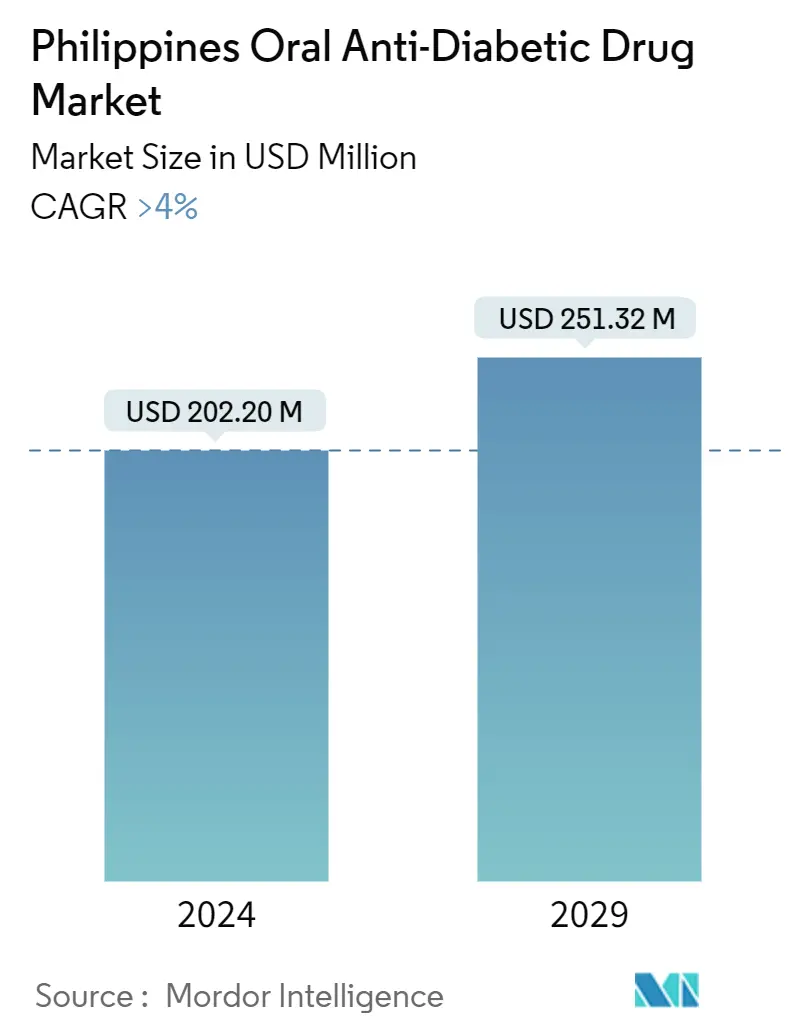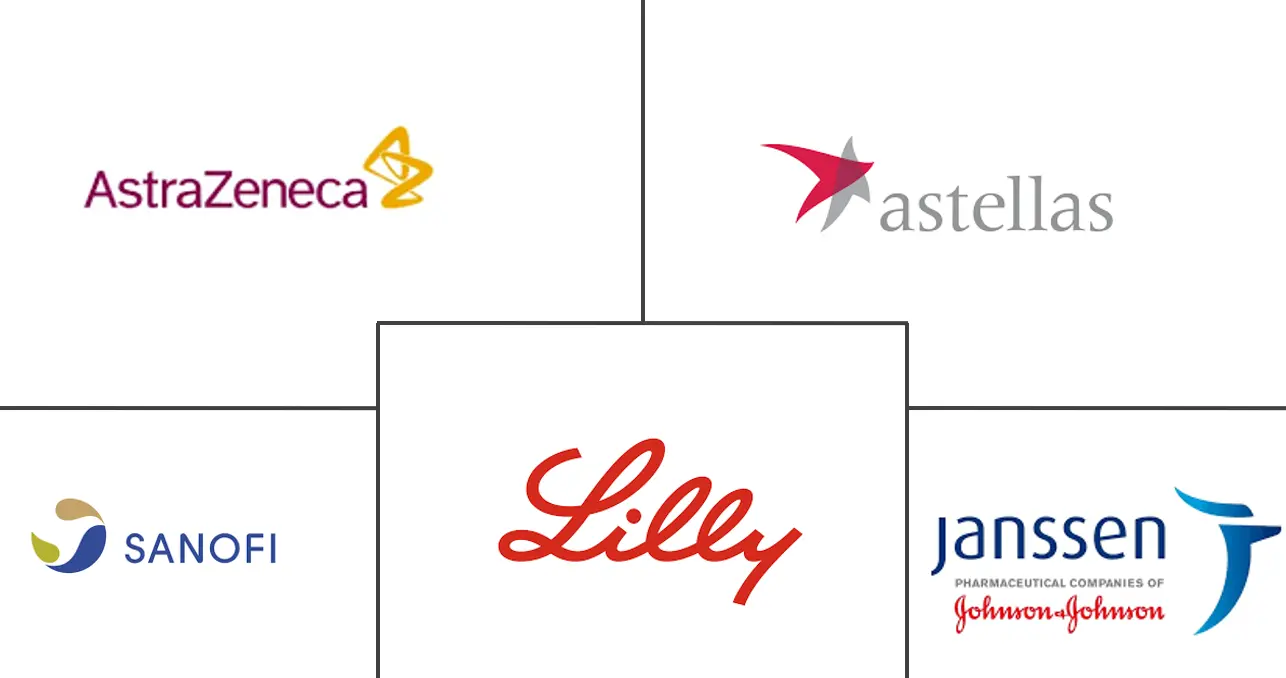Market Size of Philippines Oral Anti-Diabetic Drug Industry

| Study Period | 2019 - 2029 |
| Base Year For Estimation | 2023 |
| Forecast Data Period | 2024 - 2029 |
| Market Size (2024) | USD 202.20 Million |
| Market Size (2029) | USD 251.32 Million |
| CAGR (2024 - 2029) | > 4.00 % |
Major Players
*Disclaimer: Major Players sorted in no particular order |
Philippines Oral Anti-Diabetic Drug Market Analysis
The Philippines Oral Anti-Diabetic Drug Market size is estimated at USD 202.20 million in 2024, and is expected to reach USD 251.32 million by 2029, growing at a CAGR of greater than 4% during the forecast period (2024-2029).
A new disease known as a SARS-CoV-2 viral strain brings on COVID-19. Most infected individuals will experience mild to moderate respiratory disease and recover without special care. Serious illnesses are more likely to affect the elderly and people with underlying medical disorders such as diabetes, hypertension, heart disease, lung disease, obesity, and cancer. The virus enters the heart, lungs, and other bodily cells, triggering inflammatory changes that harm several organs and cause inflammation.
Systemic inflammation and diabetes have been linked. Studies have shown that individuals with diabetes had increased viral entry, a lowered immune response, reduced viral clearance, and dysregulated inflammatory markers. Diabetes patients may be just as susceptible to COVID-19 infection as healthy individuals.
On the other hand, because diabetes is a core component of the illness, people with diabetes have a greater risk of hospitalization, ICU admissions, severe sequelae, and fatality after contracting COVID-19. Diabetes patients may have an equal chance of contracting COVID-19 as people without the disease. However, because diabetes is a key illness feature, those who get COVID-19 are more likely than those without diabetes to require hospitalization, be admitted to an intensive care unit (ICU), experience severe consequences, and die.
The insulin medication category holds a substantial market share. Insulin is used by more than 100 million individuals globally, including 100% of those with Type 1 diabetes and 10% to 25% of those with Type 2 diabetes. Only a few insulin producers are operating on the market, and insulin production is complex. As a result, there is intense competition among these companies, which always work to meet patients' needs by offering insulin of the best caliber.
High blood sugar levels caused by poor insulin generation and activity characterize the complex disease known as diabetes. The pancreatic hormone insulin regulates the body's blood sugar levels. Uncontrolled diabetes has several negative effects, such as renal failure, blindness, leg amputation, heart attack, and stroke. Data from the DOST-FNRI indicate that 14.2% of people have prediabetes. Out of every five Filipinos, one develops diabetes or prediabetes, which together causes abnormal glucose levels.
Philippines Oral Anti-Diabetic Drug Industry Segmentation
Orally administered antihyperglycemic drugs reduce blood glucose levels. They are often used in type 2 diabetes care. The Philippines oral anti-diabetic drug market is segmented into drugs. The report offers the market size in value terms in USD and Volume in terms of Unit for all the abovementioned segments.
| Oral Anti-diabetic drugs | ||||||
| ||||||
| ||||||
| ||||||
| ||||||
| ||||||
| ||||||
|
Philippines Oral Anti-Diabetic Drug Market Size Summary
The Philippines Oral Anti-Diabetic Drug Market is poised for growth, driven by the increasing prevalence of diabetes and the demand for effective treatment options. The market is characterized by a significant reliance on oral anti-diabetic drugs, with metformin and sulfonylureas being the most prescribed due to their affordability and availability. Despite the challenges posed by rapid urbanization and lifestyle changes contributing to the rise in diabetes cases, the market remains focused on addressing the healthcare needs of the population. The insulin segment holds a substantial share, although its production is complex and competitive, with major global players like Eli Lilly, AstraZeneca, Sanofi, and Janssen Pharmaceuticals dominating the market. These companies are continually innovating to meet the evolving demands of diabetes care.
The healthcare landscape in the Philippines is marked by a lack of comprehensive coverage for diabetes care, with most patients relying on out-of-pocket expenses for treatment and management. This economic factor, coupled with cultural dietary preferences, poses significant challenges to effective diabetes management. The government's national insurance program and private insurers offer limited coverage, leaving a gap in preventive and comprehensive care. Noncommunicable diseases, including diabetes, are a leading cause of mortality, highlighting the urgent need for improved healthcare resources and support. Recent regulatory approvals, such as the treatment for diabetic macular edema and new diabetes medications, indicate a positive trend towards enhancing diabetes care and management in the country.
Philippines Oral Anti-Diabetic Drug Market Size - Table of Contents
-
1. MARKET DYNAMICS
-
1.1 Market Overview
-
1.2 Market Drivers
-
1.3 Market Restraints
-
1.4 Porter's Five Forces Analysis
-
1.4.1 Bargaining Power of Suppliers
-
1.4.2 Bargaining Power of Consumers
-
1.4.3 Threat of New Entrants
-
1.4.4 Threat of Substitute Products and Services
-
1.4.5 Intensity of Competitive Rivalry
-
-
-
2. MARKET SEGMENTATION
-
2.1 Oral Anti-diabetic drugs
-
2.1.1 Biguanides
-
2.1.1.1 Metformin
-
-
2.1.2 Alpha-Glucosidase Inhibitors
-
2.1.2.1 Alpha-Glucosidase Inhibitors
-
-
2.1.3 Dopamine D2 receptor agonist
-
2.1.3.1 Bromocriptin
-
-
2.1.4 SGLT-2 inhibitors
-
2.1.4.1 Invokana (Canagliflozin)
-
2.1.4.2 Jardiance (Empagliflozin)
-
2.1.4.3 Farxiga/Forxiga (Dapagliflozin)
-
2.1.4.4 Suglat (Ipragliflozin)
-
-
2.1.5 DPP-4 inhibitors
-
2.1.5.1 Onglyza (Saxagliptin)
-
2.1.5.2 Tradjenta (Linagliptin)
-
2.1.5.3 Vipidia/Nesina(Alogliptin)
-
2.1.5.4 Galvus (Vildagliptin)
-
-
2.1.6 Sulfonylureas
-
2.1.6.1 Sulfonylureas
-
-
2.1.7 Meglitinides
-
2.1.7.1 Meglitinides
-
-
-
Philippines Oral Anti-Diabetic Drug Market Size FAQs
How big is the Philippines Oral Anti-Diabetic Drug Market?
The Philippines Oral Anti-Diabetic Drug Market size is expected to reach USD 202.20 million in 2024 and grow at a CAGR of greater than 4% to reach USD 251.32 million by 2029.
What is the current Philippines Oral Anti-Diabetic Drug Market size?
In 2024, the Philippines Oral Anti-Diabetic Drug Market size is expected to reach USD 202.20 million.

